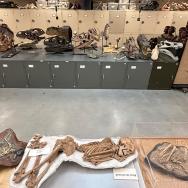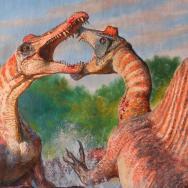The University of Chicago Medicine made prehistory by caring for a Chicago icon on Dec. 8.
The right arm of SUE the Tyrannosaurus rex underwent a CT scan at the UChicago Medicine Center for Care and Discovery to help museum researchers understand how the T. Rex used its famously short arms.
SUE is the largest and most complete Tyrannosaurus rex skeleton ever discovered, at more than 40 feet long. The fossil, one of the most famous in the world, has its permanent home at the Field Museum in Chicago.
Well-preserved T. rex arms are rarely found, so CT scans of SUE’s bones at the University of Chicago will be a big step in understanding how the dinosaur moved, the Field Museum said. (The skeleton on display will have a temporary “prosthetic arm” while the bones are in transit.)
Field Museum paleontologist Jingmai O’Connor said the CT scans of SUE’s shoulder girdle and forelimb will be used to create digital models to determine range of motion and force.
Photo gallery 1/4
Jokes about T. rex’s arms being useless for push-ups have perhaps proliferated because scientists aren’t actually quite sure why its arms are so short. “Jokes aside, the proportions of these forelimbs are very strange,” O’Connor told CBS Chicago.
It’s not the first time the UChicago Medicine’s radiology team has worked with the Field Museum on CT scans of dinosaur fossils, but SUE is certainly their most famous “patient.”
The connection was made through Christopher Straus, UChicago Medicine Professor of Radiology and Director of Medical Student Education.
“Support across our campus and our great Chicago institutions is so important to our collective success,” Straus said. “In addition to our patient care responsibilities, the opportunity for us as imaging experts to assist other scientists with the most advanced equipment epitomizes our mission at UChicago Medicine.”
The radiology team also regularly works with paleontologists from UChicago’s Biological Sciences Division.
“We’re happy to do this type of work. It’s fun for us,” said Nick Gruszauskas, Technical Director of the UChicago Medicine Human Imaging Research Office and the one who completed the scans.












